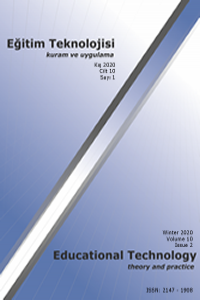Öz
Son zamanlarda küresel ve ulusal ölçekte hissedilen ihtiyaçlar ve zorunluluklar nedeniyle teknolojiye dayalı öğretim yaklaşımlarının kullanılmasına ilişkin beklentiler artmış; üniversiteler bu beklentileri karşılamak için farklı uygulama arayışı içine girmişlerdir. Ders Yakalama Sistemi (DYS) bu uygulamalardan birisidir ve amacı, öğretim elemanının, çevrimiçi olarak ya da ders kayıtlarında gerekli gördüğü değişiklikleri yaptıktan sonra dersini, öğrenci erişimine açarak öğrencinin kendi ihtiyacı doğrultusunda bilgiye ulaşmasını ve tekrar etmesini sağlamaktır. Bu çalışmada, bir yükseköğretim kurumundaki öğrencilerin DYS’yi kullanım amaçları, DYS’ye ilişkin yarar algıları ve DYS kullanımı ile ilgili algıladıkları kısıtlılıklara ilişkin görüşlerinin betimlenmesi amaçlanmıştır. Araştırma sonuçları, öğrencilerin DYS sistemini işlevsel ve yararlı bulduklarını, en çok sınavdan önce konuları gözden geçirmek, derste kaçırdığı ya da derse gelemediği durumlarda öğrenme eksikliklerini kapatmak için kullandıklarını ancak sisteme ulaşımda yaşadıkları en önemli kısıtlılığın teknik aksaklıklar olduğunu göstermiştir. Bu çalışma, teknolojiye dayalı öğretim yaklaşımlarının daha fazla önem kazandığı ve kullanıldığı günümüzde söz konusu yaklaşımların pedagojik değerini ön plana çıkaran araştırmaların yürütülmesini önermektedir.
Anahtar Kelimeler
ders yakalama sistemi; eş zamanlı ders kaydı; video ders anlatım; öğrenci görüşü; yükseköğretim
Destekleyen Kurum
İzmir Ekonomi Üniversitesi
Proje Numarası
2018-10
Teşekkür
Prof. Dr. Petek Aşkar'a proje süresince göstermiş olduğu rehberlik için teşekkür ederiz. İzmir Ekonomi Üniversitesine proje süreci boyunca verdiği destek için teşekkür ederiz.
Kaynakça
- Al Nashash, H., ve Gunn, C. (2013). Lecture capture in engineering classes: Bridging gaps and enhancing learning. Educational Technology & Society, 16(1), 69-78.
- Aldamen, H., Al-Esmail, R., ve Hollindale, J. (2015). Does lecture capturing impact student performance and attendance in an introductory accounting course?. Accounting Education, 24(4), 291-317.
- Brooks, C., Erickson, G., Greer, J., ve Gutwin, C. (2014). Modelling and quantifying the behaviours of students in lecture capture environments. Computers & Education, 75, 282-292.
- Danielson, J., Preast, V., Bender, H., ve Hassall, L. (2014). Is the effectiveness of lecture capture related to teaching approach or content type. Computers & Education, 72, 121-131.
- Dommett, E. J., Gardner, B., ve van Tilburg, W. (2019). Staff and student views of lecture capture: A qualitative study. International Journal of Educational Technology in Higher Education, 16:23.
- Dommeyer, C. J. (2017). Lecture capturing: Its effects on students' absenteeism, performance, and impressions in a traditional marketing research course. Journal of Education for Business, 92(8), 388-395.
- Dona, K. L., Gregory, J., ve Pechenkina, E. (2017). Lecture-recording technology in higher education: Exploring lecturer and student views across the disciplines. Australasian Journal of Educational Technology, 33(4), 122-133.
- Dinmore, S. (2019). Beyond lecture capture: Creating digital video content for online learning – a case study. Journal of University Teaching & Learning Practice, 16(1), 7, 1-10.
- Edwards, M. R., ve Clinton, M. E. (2019). A study exploring the impact of lecture capture availability and lecture capture usage on student attendance and attainment. High Educ, 77, 403–421.
- Elliott, C., ve Neal, D. (2016). Evaluating the use of lecture capture using a revealed preference approach. Active Learning in Higher Education, 17(2), 153-167.
- Evans, G., ve Luke, K. (2020). Lecture capture and peer working: exploring study practices through staff–student partnerships. Research in Learning Technology, 28, 1-13.
- Farooq, M. S., Salam, M., Jaafar, N., Fayolle, A., Ayupp, K., Radovic-Markovic, M., ve Sajid, A. (2017). Acceptance and use of lecture capture system (LCS) in executive business studies extending UTAUT2. Interactive Technology and Smart Education, 14(4), 329-348.
- Germany, L. (2012). Beyond lecture capture: What teaching staff want from web-based lecture technologies. Australiasian Journal of Educational Technology, 28(7), 1208-1220.
- Hall, G., ve Ivaldi, A. (2017). A qualitative approach to understanding the role of lecture capture in student learning experiences. Technology Pedagogy and Education, 26(4), 383-394.
- Johnson, R. B., & Onwuegbuzie, A. J. (2004). Mixed methods research: A research paradigm whose time has come. Educational Researcher, 33(7), 14-26.
- Joseph-Richard, P., Jessop, T., Okafor, G., Almpanis, T., ve Price, D. (2018). Big brother or harbinger of best practice: Can lecture capture actually improve teaching?. British Educational Research Journal, 44(3), 377-392.
- Khee, C. M., Wei, G. W., ve Jamaluddin, S. A. (2014). Students’ perception towards lecture capture based on the Technology Acceptance Model. Procedia-Social and Behavioral Sciences, 123, 461-469.
- Luke, K. (2020). The pause/play button actor-network: lecture capture recordings and (re)configuring multi-spatial learning practices. Interactive Learning Environments, DOI: 10.1080/10494820.2019.1706052.
- Rahman, A., Shah, M. A. R., ve Chowdhury, S. H. (2017). Lecture capture use in engineering education: Influence of students’ social and behavioral factors and teachers’ perceptions. Comput Appl Eng Educ., 26, 500–508.
- Yıldırım, A. Ve Şimşek, H. (2013). Sosyal Bilimlerde Nitel Araştırma Yöntemleri. (9. Baskı). Ankara: Seçkin Yayınları.
- Yu, P.-T., Wang, B. –Y., ve Su, M. –H. (2015). Lecture capture with real-time rearrangement of visual elements: impact on student performance. Journal of Computer Assisted Learning, 31, 655-670.
- Williams, A. E., Aguilar-Roca, N. M., ve O’Dowd, D. K. (2015). Lecture capture podcasts: differential student use and performance in a large introductory course. Educational Technology Research & Development, 64, 1-12.
- Witton, G. (2017). The value of capture: Taking an alternative approach to using lecture capture technologies for increased impact on student learning and engagement. British Journal of Educational Technology, 48(4), 1010-1019.
Ayrıntılar
| Birincil Dil | Türkçe |
|---|---|
| Bölüm | Makaleler |
| Yazarlar | |
| Proje Numarası | 2018-10 |
| Yayımlanma Tarihi | 31 Temmuz 2020 |
| Yayımlandığı Sayı | Yıl 2020 Cilt: 10 Sayı: 2 |

